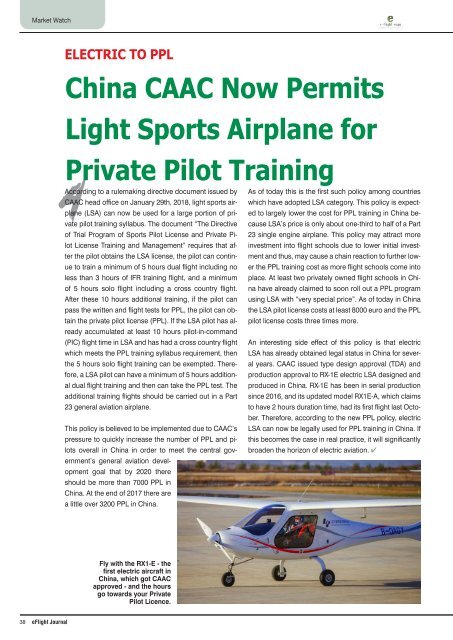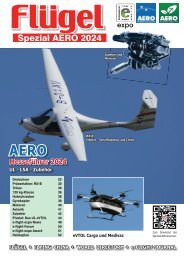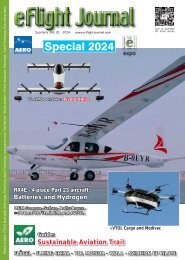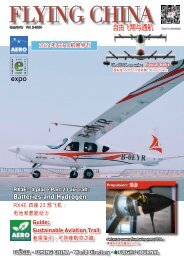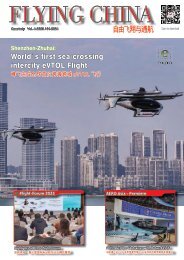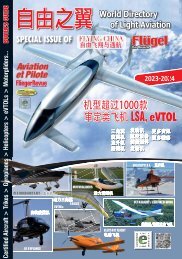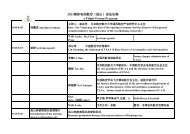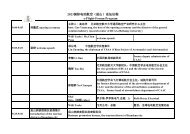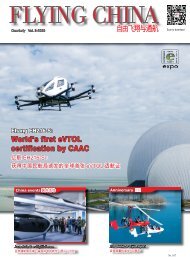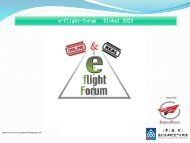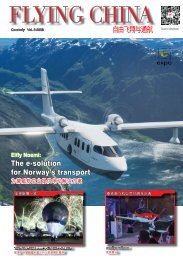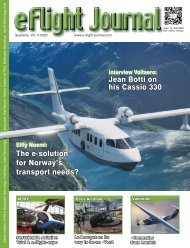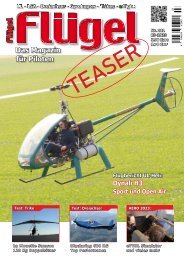You also want an ePaper? Increase the reach of your titles
YUMPU automatically turns print PDFs into web optimized ePapers that Google loves.
Market Watch<br />
ELECTRIC TO PPL<br />
China CAAC Now Permits<br />
Light Sports Airplane for<br />
Private Pilot Training<br />
AAccording to a rulemaking directive document issued by<br />
CAAC head office on January 29th, <strong>2018</strong>, light sports airplane<br />
(LSA) can now be used for a large portion of private<br />
pilot training syllabus. The document “The Directive<br />
of Trial Program of Sports Pilot License and Private Pilot<br />
License Training and Management” requires that after<br />
the pilot obtains the LSA license, the pilot can continue<br />
to train a minimum of 5 hours dual <strong>flight</strong> including no<br />
less than 3 hours of IFR training <strong>flight</strong>, and a minimum<br />
of 5 hours solo <strong>flight</strong> including a cross country <strong>flight</strong>.<br />
After these 10 hours additional training, if the pilot can<br />
pass the written and <strong>flight</strong> tests for PPL, the pilot can obtain<br />
the private pilot license (PPL). If the LSA pilot has already<br />
accumulated at least 10 hours pilot-in-command<br />
(PIC) <strong>flight</strong> time in LSA and has had a cross country <strong>flight</strong><br />
which meets the PPL training syllabus requirement, then<br />
the 5 hours solo <strong>flight</strong> training can be exempted. Therefore,<br />
a LSA pilot can have a minimum of 5 hours additional<br />
dual <strong>flight</strong> training and then can take the PPL test. The<br />
additional training <strong>flight</strong>s should be carried out in a Part<br />
23 general aviation airplane.<br />
This policy is believed to be implemented due to CAAC’s<br />
pressure to quickly increase the number of PPL and pilots<br />
overall in China in order to meet the central government’s<br />
general aviation development<br />
goal that by 2020 there<br />
should be more than 7000 PPL in<br />
China. At the end of 2017 there are<br />
a little over 3200 PPL in China.<br />
As of today this is the first such policy among countries<br />
which have adopted LSA category. This policy is expected<br />
to largely lower the cost for PPL training in China because<br />
LSA’s price is only about one-third to half of a Part<br />
23 single engine airplane. This policy may attract more<br />
investment into <strong>flight</strong> schools due to lower initial investment<br />
and thus, may cause a chain reaction to further lower<br />
the PPL training cost as more <strong>flight</strong> schools come into<br />
place. At least two privately owned <strong>flight</strong> schools in China<br />
have already claimed to soon roll out a PPL program<br />
using LSA with “very <strong>special</strong> price”. As of today in China<br />
the LSA pilot license costs at least 8000 euro and the PPL<br />
pilot license costs three times more.<br />
An interesting side effect of this policy is that electric<br />
LSA has already obtained legal status in China for several<br />
years. CAAC issued type design approval (TDA) and<br />
production approval to RX-1E electric LSA designed and<br />
produced in China. RX-1E has been in serial production<br />
since 2016, and its updated model RX1E-A, which claims<br />
to have 2 hours duration time, had its first <strong>flight</strong> last October.<br />
Therefore, according to the new PPL policy, electric<br />
LSA can now be legally used for PPL training in China. If<br />
this becomes the case in real practice, it will significantly<br />
broaden the horizon of electric aviation. 4<br />
Fly with the RX1-E - the<br />
first electric aircraft in<br />
China, which got CAAC<br />
approved - and the hours<br />
go towards your Private<br />
Pilot Licence.<br />
38 e Flight Journal


